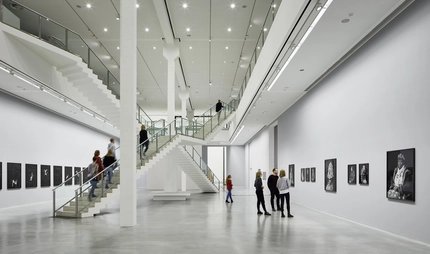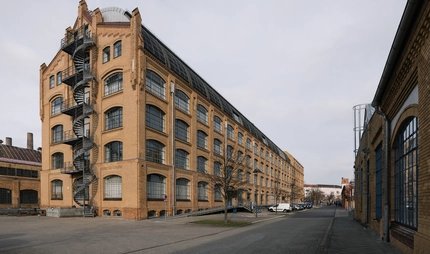
Georg Kolbe Museum
In the famous sculptor's studio
The Georg Kolbe Museum exhibits works of classical modernism and contemporary art. As the only artist's studio in Berlin from the 1920s to be open to the public, the listed ensemble is a living testimony to this era.
Each year, the museum uses its 400 m² of exhibition space to host special shows a year related to current contemporary art or to classical modernism, mostly with a focus on sculpture (including the likes of Auguste Rodin, Hans Arp, and Renée Sintenis).

New Objectivity
The museum in Berlin's Westend district is located in two adjacent buildings that were the home and studio of artist Georg Kolbe (1877-1947). Built between 1928 and 1929 in the style of New Objectivity, it is no coincidence that they are reminiscent of works by such major architects as Ludwig Mies van der Rohe and Walter Gropius. Georg Kolbe had these two cubic brick buildings connected by a park-like garden with an old stand of pine as a home for him and his family. The museum presents its exhibitions in Kolbe's former sculptor's studio, which not only features a large skylight, but also the rails that the artist could use to move heavy pieces he was working on. Kolbe's living room is now home to the museum's front desk and the museum shop is housed in the former dining room, where the original furniture is also still preserved.
Berlin Secession
Georg Kolbe was the most successful German sculptor in the first half of the 20th century. His expressive sculptures, some of which can be seen in the museum gardens and in nearby Georg-Kolbe-Hain park, reflect the zeitgeist of Berlin as a centre of art at the turn of the last century. Particularly revealing for an understanding of their context is their close connection to the now iconic architecture of modernity. Kolbe worked with Walter Gropius, Bruno Taut, Henry van de Velde, Hans Poelzig, and many other modern architects. Ludwig Mies van der Rohe, for example, placed "Morgen" ("Morning"), Kolbe's sculpture of a female figure with her arms raised to the sun, in the water feature at his legendary Barcelona Pavilion.
As one of the leading members of the Berlin Secession and later the Free Secession, Georg Kolbe had been considered one of the most renowned artists in Germany since the early 20th century. He was friends with Karl Schmidt-Rottluff, Ernst Ludwig Kirchner, Ernst Barlach, Renée Sintenis, and many other artists of the period. His sculptures and drawings can now be found in many major museums and public places all over Germany.
The museum's collection, only a part of which is on display at a time, includes works by the artist that were left in his estate as well as his personal art collection (with works by Karl Schmidt-Rottluff, Ernst Ludwig Kirchner, Auguste Rodin, Aristide Maillol), as well as the partial estates of Renée Sintenis and Richard Scheibe.

An all-round experience
The enchanting museum campus with its sculptures by Kolbe is also a short walk from the Georg-Kolbe-Hain, a park featuring some of teh artist's larger pieces. Also nearby is the scenic Heerstraße Cemetery, where not only Kolbe, but also German comedian Loriot, Horst Buchholz, and Paul Cassirer are buried. In addition, there are a number of famous listed buildings near the museum: other famous villas in the New Objectivity style of the 1920s, the Corbusier House, the Olympic Stadium, and Hans Poelzig's Haus der Rundfunk (Radio House) on Masurenalle with the sculpture "Nacht" ("Night") by Georg Kolbe.
What you can discover in Georg Kolbe's "Sensburg":
- The only artist's studio in Berlin from the 1920s to be open to the public
- Sculptor's studio with idyllic garden, dancers' fountain, and café (wonderful excursion destination)
- Berlin modernist architecture (New Objectivity)
- Works and contemporaries of the most successful German sculptor in the first half of the 20th century
Our tips for your visit to the Georg Kolbe Museum
The Georg Kolbe Museum is just 300 metres from Heerstraße station on S-Bahn line S5. Alternatively, the M49, X49 and 218 buses also serve the station. Drivers can park directly on Sensburger Allee. There is a disabled access.
Museum Pass holders enjoy free admission. Public tours are available at an additional cost. Individual group tours should be booked in advance.
Infos für Familien und Kinder
Together with your children, you can also visit interesting workshops as part of your tour of the exhibitions. Advance registration required.
Further Berlin recommendations for sculpture lovers: Kunsthaus Dahlem and Bode Museum
It takes about 30 minutes to reach Dahlem on the S-Bahn. This district in the far west of Berlin is home to Kunsthaus Dahlem, which focuses on post-war political and modernist sculpture from both East and West Germany. Works on display here include Prometheus Chained II and Maja by Gerhard Marcks. Also remarkable are the sculptures by Hans Uhlmann and Jeanne Mammen as well as the extensive sculpture garden with works by Bernhard Heiliger. The museum is housed in the former studio house of Hitler's "state sculptor" Arno Breker and, after 1945, served as a studio space for many artists who lived and worked here. These included Bernhard Heiliger, Emilio Vedova, and Fluxus pioneer Wolf Vostell.
Berlin's most extensive collection of sculptures, meanwhile, can be viewed in the city centre at the Bode Museum on Museum Island. You are greeted by a monumental equestrian statue of Frederick the Great right in the museum's entrance hall. Afterwards, you are treated to works by the likes of Donatello, Francesco Lauranas, Ignaz Günther, and Pierre Pugets. In addition to the sculpture collection, the Bode Museum houses the Museum of Byzantine Art and the state coin collection.
Opening hours
| Monday | |
|---|---|
| Wednesday | |
| Thursday | |
| Friday | |
| Saturday | |
| Sunday |
closed on tuesdays



